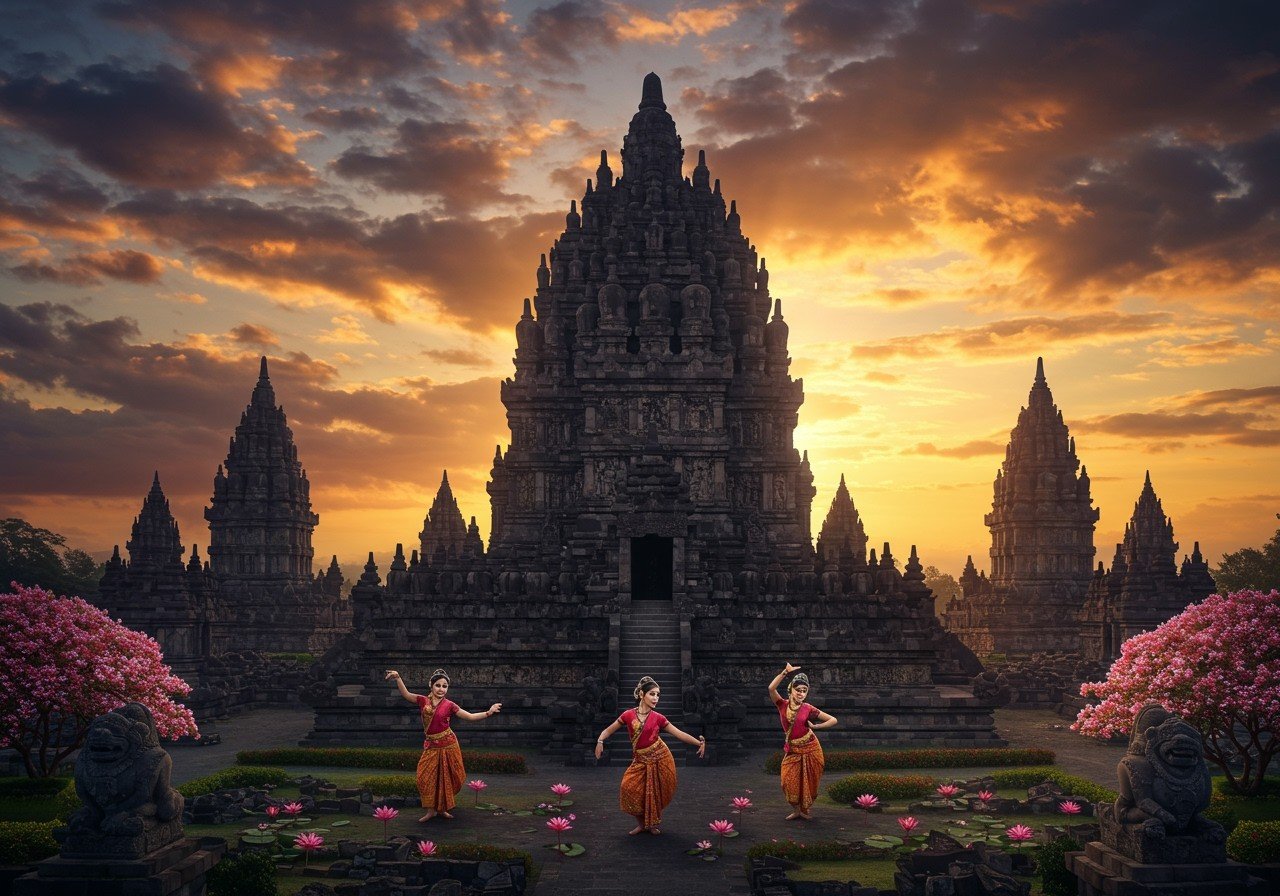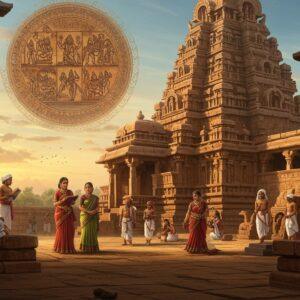
Embark on a captivating exploration of Prambanan Temple, a magnificent 9th-century Hindu temple complex nestled in the heart of Central Java, Indonesia. As one of Southeast Asia’s largest and most revered Hindu sanctuaries, Prambanan beckons with a treasure trove of history, captivating legends, and ancient secrets waiting to be unveiled. Let’s delve into the rich cultural heritage and architectural grandeur that continues to mesmerize visitors from every corner of the globe.
A Glimpse into the Past: Historical Background
Prambanan Temple’s story unfolds during the zenith of the Mataram Kingdom, a powerful dynasty that held sway over Central Java. Commissioned around 850 AD by Rakai Pikatan, this architectural marvel stands as a tribute to the revered Hindu deities Shiva, Vishnu, and Brahma. Understanding the historical context surrounding its creation provides insights into the religious and political landscape of that era, as well as the profound influence of Hinduism in Southeast Asia. It’s a testament to a time when kingdoms flourished and devotion took shape in magnificent stone.
Architectural Splendor: A Symphony in Stone
Prambanan Temple is celebrated for its towering spires that pierce the sky and intricate stone carvings that narrate scenes from the timeless Hindu epic, the Ramayana. The central complex showcases three main temples dedicated to the Trimurti: Shiva, the destroyer; Vishnu, the preserver; and Brahma, the creator. Each temple boasts elaborate reliefs and sculptures, showcasing the extraordinary artistry and craftsmanship of Javanese architects during the 9th century. Imagine the dedication and skill it took to create such a masterpiece.
Purpose and Symbolism: A Reflection of the Cosmos
The construction of Prambanan Temple served a multitude of purposes, encompassing both religious and political dimensions. As a pivotal religious site, it was conceived to promote Hinduism and solidify the divine right of the Mataram rulers. The temple’s design itself is deeply symbolic, representing the cosmic mountain, Meru – a sacred axis in Hindu cosmology. This symbolism reflects the order of the universe and serves as a reminder of the gods’ celestial abode.
Legends and Myths: Whispers of Ancient Tales
Prambanan Temple is enveloped in captivating legends, the most renowned being the tale of Rara Jonggrang. This enchanting myth tells of the beautiful princess Rara Jonggrang, who was sought in marriage by Bandung Bondowoso. He built 999 temples in a single night to win her hand. However, she cleverly tricked him, and in his fury, he cursed her to become the 1000th statue, now enshrined within the temple complex. These stories add a layer of mystique to the temple’s already rich history.
Restoration and Preservation: Safeguarding a Sacred Legacy
Over the centuries, Prambanan Temple has weathered natural disasters and periods of neglect, resulting in significant deterioration. Thankfully, restoration efforts commenced in the early 20th century, and ongoing projects continue to meticulously preserve its structural integrity and artistic details. Recognizing these preservation challenges underscores the vital importance of safeguarding our cultural heritage for generations to come. It’s a responsibility we share to protect these treasures.
Cultural and Religious Significance: A Living Tradition
Today, Prambanan Temple remains a shining beacon of cultural pride and spiritual devotion for the Indonesian people. It serves as a vibrant center for traditional ceremonies, where time-honored rituals are performed with deep reverence. These ceremonies, steeped in Hindu customs, offer a glimpse into the rich tapestry of beliefs that continue to thrive in this region. It is a place where the past connects with the present.
The temple also hosts the annual Ramayana Ballet, a mesmerizing performance that brings this epic tale to life through graceful dance and enchanting music. As the sun dips below the horizon, the temple’s majestic silhouette forms a magical backdrop for this cultural spectacle. Visitors are transported back in time, feeling the legends come alive and connecting with the spirit of ancient Java.
Prambanan Temple embodies the resilience of cultural heritage. Its continued use for religious practices underscores its enduring significance. For those who visit, it offers a profound sense of continuity and a deep connection to traditions that have spanned centuries. This enduring legacy fosters a strong sense of identity and community among the people. It’s a reminder of the strength and beauty of tradition.
Preserving this sacred site is paramount, not only for its artistic beauty but also for the stories it holds within its stones. The ongoing efforts to maintain Prambanan ensure that future generations can marvel at its grandeur and participate in its timeless traditions. It stands tall as a testament to the spirit of a civilization that cherished both art and devotion.
How Poojn.in Helps You Connect with Hindu Temple Heritage
At Poojn.in, we offer authentic puja items, carefully curated to help you maintain a strong connection to sacred Hindu temples like Prambanan. Our products are designed to support your spiritual journey and enrich your temple worship practices. We understand the importance of having the right items for your puja.
For Your Home Temple:
- Temple-grade Brass and Copper Idols: Bring the divine presence into your home with meticulously crafted idols, perfect for your personal shrine. Choose from a variety of deities, each imbued with sacred significance.
- Puja Thalis for Complete Ritual Offerings: Perform your daily puja with ease and reverence using our beautifully designed thalis. These complete sets contain everything you need for a fulfilling ritual experience.
- Pure Cotton Wicks and Premium Ghee for Daily Aarti: Illuminate your home temple with the pure glow of aarti using our premium cotton wicks and pure ghee. Experience the traditional way of offering light to the divine.
- Traditional Incense Holders and Dhoop Stands: Create a serene and sacred atmosphere with our elegant incense holders and dhoop stands. These beautiful pieces add a touch of traditional elegance to your home temple.
We offer convenient shopping options:
- Order Online: poojn.in
- Call Us: 03369029784
- WhatsApp: 9476142738
All products are carefully packaged and delivered safely across India. Our dedicated team is also available to provide guidance on the proper usage of items for your temple rituals.
Visit poojn.in today to discover our complete collection of temple worship items. We are dedicated to preserving sacred traditions while making them accessible for modern devotees like you. We’re here to support you on your spiritual path.
Panchmukhi Hanuman Idol
Brass Lord Kubera Idol
Embracing the Legacy of Prambanan
Prambanan Temple transcends its identity as a mere historical site; it stands as a living testament to cultural heritage and profound spiritual devotion. Its walls whisper tales of bygone eras, while its grounds continue to host vibrant traditions. A visit to Prambanan is like stepping into a realm where history and legend intertwine, offering a unique and enriching experience. It’s a journey that nourishes the soul.
As custodians of this magnificent legacy, we bear the responsibility of cherishing and protecting Prambanan. By doing so, we guarantee that its beauty and significance will endure for generations to come. Let us embrace the wisdom and traditions of the past, celebrating them as an integral part of our shared human heritage. In preserving Prambanan, we keep alive the spirit of a community that values both its history and its future. It’s a gift we give to ourselves and to those who will follow.
FAQs about Prambanan Temple
When was Prambanan Temple constructed?
Prambanan Temple, a magnificent Hindu complex in Central Java, Indonesia, was built around the mid-9th century AD, specifically commencing around 850 AD. The construction spanned the reigns of multiple kings, including Rakai Pikatan, Lokapala, and Balitung Maha Sambu of the Sanjaya dynasty.
What inspired the construction of Prambanan?
Prambanan was built to honor the Hindu trinity – Brahma, the creator; Vishnu, the preserver; and Shiva, the destroyer. Historians believe it also symbolized the resurgence of the Hindu Sanjaya dynasty in Central Java, serving as a counterpoint to the Buddhist monuments of the prior Sailendra dynasty. It signified a shift in royal patronage from Mahayana Buddhism back to Shaivite Hinduism.
Could you share the legend associated with Prambanan?
The famous legend of Rara Jonggrang gives the temple complex its alternate name. Prince Bandung Bondowoso, after slaying King Boko, desired to marry the king’s daughter, Princess Rara Jonggrang. She refused but proposed an impossible task: building 1,000 temples in a single night. He almost succeeded with supernatural aid, but she tricked him, causing him to curse her into becoming the 1,000th temple’s statue, thought to be Durga in the Shiva temple.
How many temples constitute the Prambanan complex?
Originally, the Prambanan complex housed 240 temple structures, showcasing the grandeur of the Mataram Kingdom. Over time, natural disasters and political shifts led to the complex’s decline. Today, while remnants of the smaller temples remain, the primary focus is on the restored central compound dedicated to the Trimurti.
What distinguishes the architectural style of Prambanan Temple?
Prambanan showcases classic Hindu architecture, characterized by towering, pointed structures reaching impressive heights. The main tower soars to 47 meters. Intricate carvings adorn the temple walls, depicting scenes from the Ramayana epic, adding to the temple’s artistic richness. The central compound highlights three main temples, each dedicated to a deity of the Trimurti: Shiva, Vishnu, and Brahma.
Is Prambanan Temple recognized as a UNESCO World Heritage Site?
Yes, Prambanan Temple received UNESCO World Heritage Site designation in 1991. This recognition acknowledges its exceptional cultural value and its remarkable architectural achievements. It is a testament to the temple’s importance in global heritage.
Can visitors explore the interior of Prambanan Temple?
Yes, visitors are welcome to explore the interior of Prambanan Temple. Walking through the temple’s chambers and corridors allows one to appreciate its historical significance and admire the intricate details of its architecture. It’s a journey through time and devotion.
What is the ideal time to visit Prambanan Temple?
The most favorable time to visit Prambanan Temple is during the dry season, typically between May and September. During this period, the weather is generally pleasant and conducive to exploring the expansive temple complex. The clear skies also provide stunning photo opportunities.
Mallikarjuna Temple: A History of Legends and Significance
Martand Sun Temple: Symbolism, Legends, and History


